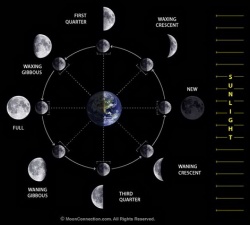Uposatha
1. Observance of the Eight Precepts;
2. Bi-weekly recitation of the Vinaya rules by a chapter of Buddhist monks
The uposatha are the days of the full moon, half moon and the two quarter moons of each month in the ancient Indian calendar. The day of the full moon (puṇṇamā) was the most important uposatha and marked the beginning of the month. In pre-Buddhist times the upavasatha was the fasting day preceding the Vedic sacrifice. This Sanskrit word and its Pāḷi equivalent mean something like ‘fulfilled.’ In some ways the uposatha is similar to the Jewish and Christian Sabbath, except, of course, that it is not obligatory to observe it. However, the Buddha certainly recommended lay Buddhists use these holidays to ‘purify the soiled mind in the right way’ (upakkilittassa cittassa upakkamena pariyodapana, A.I,207). He encouraged them to pay homage to their parents on such days, to do good works, spend timein quiet contemplation and abide by the eight Precepts (A.I,143; 207). To use the uposatha for such activities was, he said, like polishing a tarnished mirror (A,I,209). He praised reserving the uposatha days for such activities in these words: ‘Pearl, crystal, beryl and gold are not worth a sixteenth of the uposatha made whole with the eight Precepts. Nor is it outshone by the moon and the celestial bodies.’ (A.I,215).
Until the introduction of the Gregorian calendar in most Buddhist countries, the uposathas were public holidays. In Sinhalese they are called poya, in Burmese ubot nei, in Chinese shuo wang, and in Japanese roku sainichi. Monks and nuns use the full and half moon uposathas to chant the Pātimokkha in congregation.
